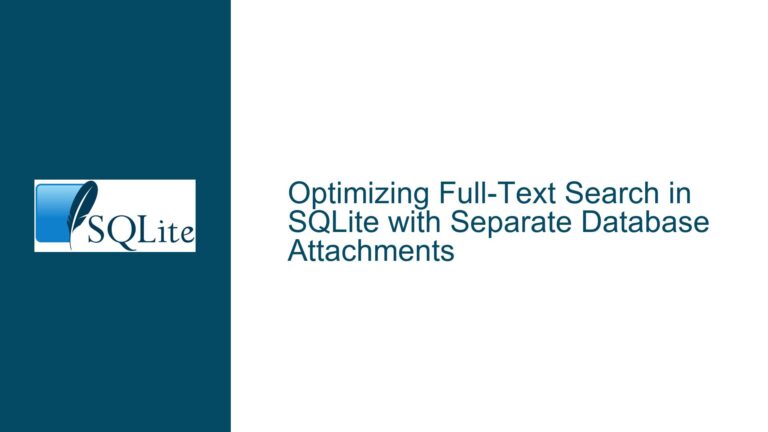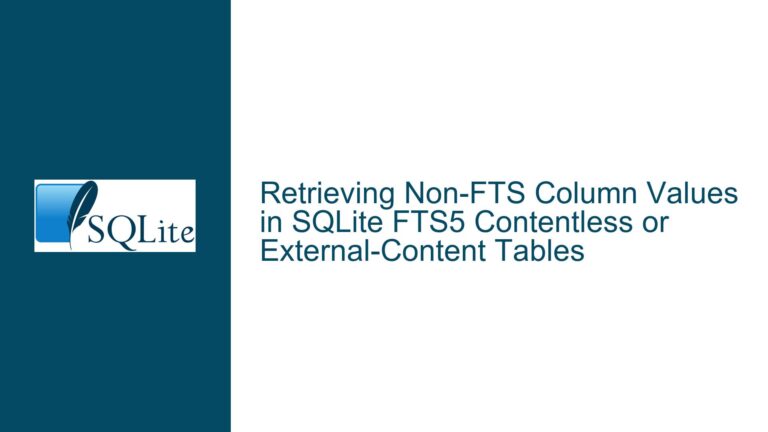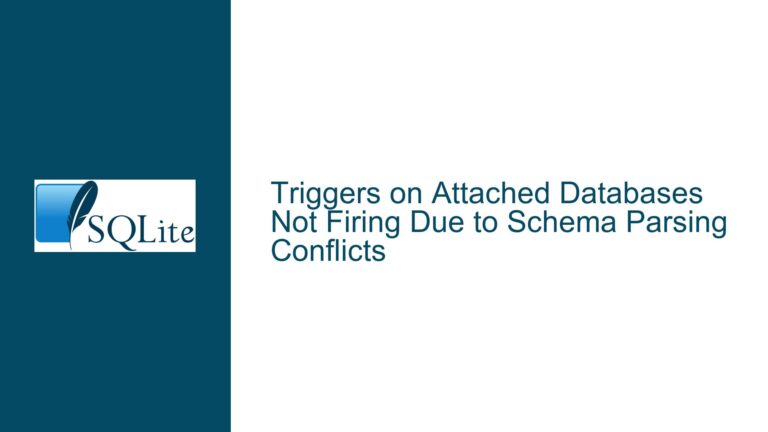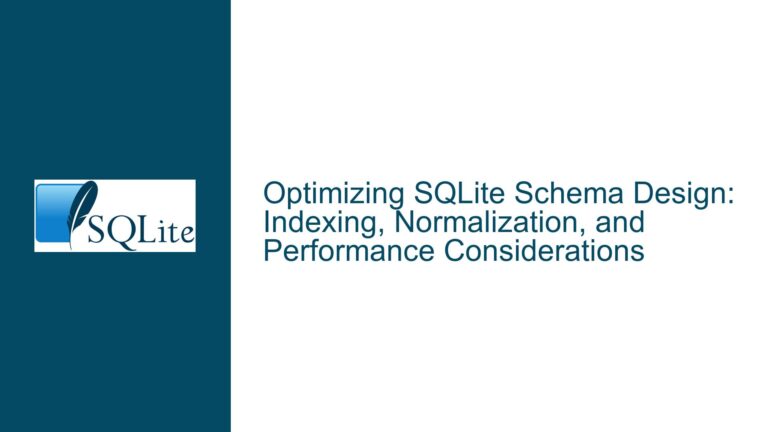Implementing Row-Level Authorization in SQLite for Role-Based Blog Access
Issue Overview: Role-Based Access Control Challenges in SQLite
The core challenge involves enforcing granular row-level permissions in a SQLite-backed application, specifically for a blog service where users must adhere to strict authorization rules. The system requires that (1) only authors or users with an "Editor" role can edit or delete blogs, and (2) deleted blogs remain accessible solely to their original authors. This demands precise coordination between SQLite’s capabilities and application-layer logic to prevent unauthorized data access while maintaining performance and code maintainability.
Three architectural paradigms emerge as candidates for implementation:
- Application-Layer Authorization Checks
- Database-Centric Permission Filtering via Subqueries/Views
- SQLite-Specific Security Extensions
Each approach introduces distinct tradeoffs in query complexity, execution efficiency, and long-term maintainability. A critical complication arises from SQLite’s lack of native session variables or built-in user context tracking, forcing developers to simulate these features through temporary tables or application-managed parameters. Additionally, the absence of row-level security (RLS) features found in enterprise databases like PostgreSQL necessitates creative workarounds using views, triggers, and virtual tables.
Possible Causes: Authorization Failure Modes and Design Pitfalls
1. Improper Layer Selection for Permission Enforcement
Centralizing authorization logic entirely within the application risks inconsistent enforcement across multiple access points (e.g., REST APIs, batch jobs). Conversely, over-reliance on SQLite’s limited security features may create performance bottlenecks due to excessive joins or subqueries. Hybrid approaches that split logic between layers often suffer from hidden coupling, where schema changes silently break permission checks.
2. Missing User Context Propagation Mechanisms
SQLite lacks session-scoped variables, making it challenging to track the current user’s identity and role during query execution. Ad-hoc solutions like temporary tables (CREATE TEMP TABLE current_user (...)) require careful transaction handling to prevent context leakage between concurrent requests. Mismanagement of this state leads to privilege escalation or false denials.
3. Inadequate Control Over Direct Table Access
Unauthorized users may bypass carefully crafted views or application logic by directly querying underlying tables (e.g., SELECT * FROM blogs). This vulnerability persists unless explicit safeguards like the sqlite3_set_authorizer callback or trigger-based validations are implemented.
4. Suboptimal Permission Query Structures
Naive implementations of row-level checks often utilize expensive cross joins (CROSS JOIN users, blogs) that degrade performance as dataset sizes grow. Poorly indexed authorization predicates (e.g., WHERE author_id = ? AND role = 'editor') exacerbate latency issues, particularly when scanning large tables.
Troubleshooting Steps, Solutions & Fixes: Secure and Scalable Authorization Patterns
Solution 1: Application-Layer Authorization with Parameterized Queries
Implementation Steps:
- Fetch User Context Early: Upon authentication, retrieve the user’s ID and role via
SELECT id, role FROM users WHERE username = ?. Cache this data in the application layer to avoid redundant queries. - Two-Phase Data Retrieval:
- First, check permissions using a parameterized query:
SELECT b.id, b.author_id, b.deleted, (u.role = 'editor' OR b.author_id = ?user_id) AS can_edit FROM blogs b JOIN users u ON b.author_id = u.id WHERE b.id = ?blog_id - Conditionally proceed with the main query (
SELECT * FROM blogs WHERE id = ?) only if permissions are granted.
- First, check permissions using a parameterized query:
- Atomic Updates with CAS Checks: For mutations, embed permission checks directly in
UPDATE/DELETEstatements:DELETE FROM blogs WHERE id = ?blog_id AND (author_id = ?user_id OR EXISTS ( SELECT 1 FROM users WHERE id = ?user_id AND role = 'editor' ))Verify affected rows post-execution to detect unauthorized attempts.
Performance Considerations:
- Indexing Strategy: Create covering indexes on
users(id, role)andblogs(author_id, deleted)to accelerate permission lookups. - Connection Pooling: Reuse database connections to amortize the cost of repeated user context queries.
Security Considerations:
- Parameter Binding: Use prepared statements exclusively to thwart SQL injection.
- Audit Logs: Log all permission denials with user ID and timestamp for forensic analysis.
Solution 2: Database-Centric Authorization Using Views and Triggers
Implementation Steps:
- Temporary User Context Table:
CREATE TEMP TABLE current_user ( user_id INTEGER PRIMARY KEY, role TEXT NOT NULL ); INSERT INTO current_user VALUES (?, ?); -- Populated by app on connection - Row-Level Security View:
CREATE VIEW secure_blogs AS SELECT b.*, CASE WHEN EXISTS ( SELECT 1 FROM current_user WHERE user_id = b.author_id OR role = 'editor' ) THEN 1 ELSE 0 END AS can_edit FROM blogs b WHERE b.deleted = 0 OR EXISTS ( SELECT 1 FROM current_user WHERE user_id = b.author_id ); - Trigger-Based Mutation Guards:
CREATE TRIGGER prevent_unauthorized_update BEFORE UPDATE ON blogs FOR EACH ROW BEGIN SELECT RAISE(ABORT, 'Unauthorized edit') WHERE NOT EXISTS ( SELECT 1 FROM current_user WHERE user_id = OLD.author_id OR role = 'editor' ); END;
Performance Considerations:
- Materialized Views: For read-heavy workloads, periodically snapshot
secure_blogsinto a physical table. - Partial Indexes: Add
WHERE deleted = 0indexes to optimize active blog queries.
Security Considerations:
- View Access Control: Revoke direct table privileges and grant
SELECTonsecure_blogsto application users. - Temp Table Isolation: Ensure each database connection has a unique
current_userinstance to prevent cross-request contamination.
Solution 3: SQLite Authorizer Callback and Virtual Tables
Implementation Steps:
- Enable Authorizer Callback:
// C API example sqlite3_set_authorizer( db, [](int actionCode, const char *arg1, const char *arg2, const char *dbName, const char *trigger) { if (actionCode == SQLITE_UPDATE && strcmp(arg1, "blogs") == 0) { return current_user.role == "editor" ? SQLITE_OK : SQLITE_DENY; } return SQLITE_OK; }, nullptr ); - Statement Virtual Tables: Using the
statement_vtabextension:CREATE VIRTUAL TABLE is_editor USING statement(( SELECT EXISTS ( SELECT 1 FROM users WHERE id = ? AND role = 'editor' ) ));Integrate into queries:
SELECT * FROM blogs WHERE id = ?blog_id AND (author_id = ?user_id OR (SELECT value FROM is_editor(?user_id)));
Performance Considerations:
- Callback Overhead: Measure authorization impact on bulk operations; batch mutations where possible.
- Virtual Table Caching: Leverage SQLite’s query planner cache for parameterized virtual tables.
Security Considerations:
- Whitelist Allowed Operations: Use the authorizer to block direct
blogstable access, funneling all reads through secured views. - Validate Virtual Table Inputs: Sanitize parameters passed to virtual tables to prevent type confusion attacks.
Cross-Solution Evaluation Matrix
| Criteria | Application Layer | Views/Triggers | Authorizer/VTabs |
|---|---|---|---|
| Performance | Moderate (2+ queries) | High (single query) | Highest (inline checks) |
| Maintainability | Easy (pure code) | Moderate (SQL) | Hard (C/SQL mix) |
| Security Robustness | Depends on app | High | Highest |
| Portability | DB-agnostic | SQLite-specific | SQLite + Extensions |
Final Recommendations:
- Start with Application-Layer Checks for simplicity, but gradually migrate critical rules to database triggers.
- Adopt
sqlite3_set_authorizerin high-security scenarios to enforce defense-in-depth. - Avoid Cross Joins in Views; instead, use correlated subqueries against
current_usertemp tables. - Benchmark Virtual Tables under production loads—while fast for simple checks, complex
statement_vtablogic may regress.






